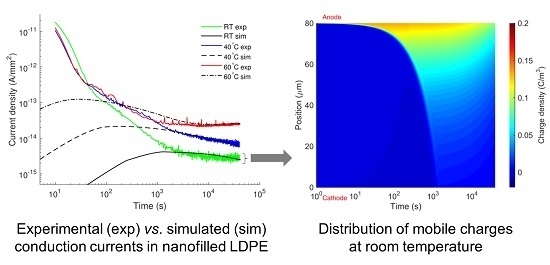Charge Transport in LDPE Nanocomposites Part II—Computational Approach
Abstract
:1. Introduction
2. Model of Charge Transport in Insulating Polymers
2.1. The Model
2.2. Computer Implementation
3. Results of the Simulations and Discussion
3.1. Charge Transport in LDPE without Nanofillers
3.2. Charge Transport in LDPE Nanocomposites
3.2.1. Model Parameterization
3.2.2. Results
3.3. Influence of Different Physical Processes on Charge Transport
3.4. Discussion
4. Conclusions
Acknowledgments
Author Contributions
Conflicts of Interest
References
- Alison, J.M.; Hill, R.M. A model for bipolar charge transport, trapping and recombination in degassed crosslinked polyethene. J. Phys. D Appl. Phys. 1994, 27, 1291–1299. [Google Scholar] [CrossRef]
- Li, Y.; Takada, T. Experimental observation of charge transport and injection in XLPE at polarity reversal. J. Phys. D Appl. Phys. 1992, 25, 704–716. [Google Scholar] [CrossRef]
- Fukuma, M.; Nagao, M.; Kosaki, M. Computer Analysis on Transient Space Charge Distribution in Polymer. In Proceedings of the 4th International Conference on Properties and Applications of Dielectric Materials, Brisbane, Queensland, Australia, 3–8 July 1994.
- Kaneko, K.; Mizutani, T.; Suzuoki, Y. Computer simulation on formation of space charge packets in XLPE films. IEEE Trans. Dielectr. Electr. Insul. 1999, 6, 152–158. [Google Scholar] [CrossRef]
- Le Roy, S.; Segur, P.; Teyssedre, G.; Laurent, C. Description of bipolar charge transport in polyethylene using a fluid model with a constant mobility: Model prediction. J. Phys. D Appl. Phys. 2004, 37, 298–305. [Google Scholar] [CrossRef]
- Le Roy, S.; Teyssedre, G.; Laurent, C.; Montanari, G.C.; Palmieri, F. Description of charge transport in polyethylene using a fluid model with a constant mobility: Fitting model and experiments. J. Phys. D Appl. Phys. 2006, 39, 1427–1436. [Google Scholar] [CrossRef]
- Boufayed, F.; Teyssèdre, G.; Laurent, C.; Roy, S.L.; Dissado, L.A.; Ségur, P.; Montanari, G.C. Models of bipolar charge transport in polyethylene. J. Appl. Phys. 2006, 100, 104105. [Google Scholar] [CrossRef]
- Serdyuk, Y.V.; Gubanski, S.M.; Mohammad, A.S. Computer Simulations of Space Charge Dynamics and Electric Fields in HVDC Cable Insulation. In Proceedings of the 15th International Symposium on High Voltage Engineering, Ljubljana, Slovenia, 27–31 August 2007; p. T8-405.
- Le Roy, S.; Vu, T.T.N.; Laurent, C.; Teyssedre, G. Modelling charge generation and transport in solid organic dielectrics under DC stress. In Proceedings of the European Seminar on Materials for HVDC Cables and Accessories: Performance, Modeling, Testing, Qualification (Jicable HVDC'13), Perpignan, France, 18–20 November 2013; p. 4.1.
- Taleb, M.; Teyssedre, G.; Le Roy, S.; Laurent, C. Modeling of charge injection and extraction in a metal/polymer interface through an exponential distribution of surface states. IEEE Trans. Dielectr. Electr. Insul. 2013, 20, 311–320. [Google Scholar] [CrossRef]
- Baudoin, F.; Laurent, C.; Teyssedre, G.; Le Roy, S. Charge packets modeling in polyethylene. Appl. Phys. Lett. 2014, 104, 152901. [Google Scholar] [CrossRef]
- Takada, T.; Hayase, Y.; Tanaka, Y.; Okamoto, T. Space charge trapping in electrical potential well caused by permanent and induced dipoles for LDPE/MgO nanocomposite. IEEE Trans. Dielectr. Electr. Insul. 2008, 15, 152–160. [Google Scholar] [CrossRef]
- Zhang, L.; Zhou, Y.; Tian, J.; Sha, Y.; Zhang, Y.; Wu, H.; Wang, Y. Experiment and simulation of space charge suppression in LDPE/MgO nanocomposite under external DC electric field. J. Electrostat. 2014, 72, 252–260. [Google Scholar] [CrossRef]
- Min, D.; Wang, W.; Li, S. Numerical analysis of space charge accumulation and conduction properties in LDPE nanodielectrics. IEEE Trans. Dielectr. Electr. Insul. 2015, 22, 1483–1491. [Google Scholar] [CrossRef]
- Fleming, R.J.; Ammala, A.; Lang, S.B.; Casey, P.S. Conductivity and space charge in LDPE containing nano- and micro-sized ZnO particles. IEEE Trans. Dielectr. Electr. Insul. 2008, 15, 118–126. [Google Scholar] [CrossRef]
- Murakami, Y.; Nemoto, M.; Okuzumi, S.; Masuda, S.; Nagao, M.; Hozumi, N.; Sekiguchi, Y. DC conduction and electrical breakdown of MgO/LDPE nanocomposite. IEEE Trans. Dielectr. Electr. Insul. 2008, 15, 33–39. [Google Scholar] [CrossRef]
- Hoang, A.T.; Pallon, L.; Liu, D.; Serdyuk, Y.V.; Gubanski, S.M.; Gedde, U.W. Charge transport in LDPE nanocomposites Part I—Experimental approach. Polymers 2016, 8, 87. [Google Scholar] [CrossRef]
- Hayase, Y.; Aoyama, H.; Tanaka, Y.; Takada, T.; Murata, Y. Space Charge Formation in LDPE/MgO Nano-Composite Thin Film under Ultra-High DC Electric Stress. In Proceedings of the 8th International Conference on Properties and Applications of Dielectric Materials, Bali, Indonesia, 26–30 June 2006; pp. 159–162.
- Kanegae, E.; Ohki, Y.; Tanaka, T.; Sekiguchi, Y.; Murata, Y.; Reddy, C.C. Space Charge Behavior in Multi-Layered Dielectrics with LDPE and LDPE/MgO Nanocomposites. In Proceedings of the 10th IEEE International Conference on Solid Dielectrics (ICSD), Potsdam, Germany, 04–09 July 2010; pp. 1–4.
- Toomer, R.; Lewis, T.J. Charge trapping in corona-charge polyethylene films. J. Phys. D: Appl. Phys. 1980, 13, 1343–1356. [Google Scholar] [CrossRef]
- Chen, G.; Tay, T.Y.G.; Davies, A.E.; Tanaka, Y.; Takada, T. Electrodes and charge injection in low-density polyethylene using the pulsed electroacoustic technique. IEEE Trans. Dielectr. Electr. Insul. 2001, 8, 867–873. [Google Scholar] [CrossRef]
- Fischer, P.; Röhl, P. Thermally stimulated and isothermal depolarization currents in low-density polyethylene. J. Polym. Sci. 1976, 14, 531–542. [Google Scholar] [CrossRef]
- Mizutani, T.; Suzuoki, Y.; Ieda, M. Thermally stimulated currents in polyethylene and ethylene–vinyl-acetate copolymers. J. Appl. Phys. 1977, 48, 2408–2413. [Google Scholar] [CrossRef]
- Tian, F.; Lei, Q.; Wang, X.; Wang, Y. Effect of deep trapping states on space charge suppression in polyethylene/ZnO nanocomposite. Appl. Phys. Lett. 2011, 99, 142903. [Google Scholar] [CrossRef]
- Ishimoto, K.; Tanaka, T.; Ohki, Y.; Sekiguchi, Y.; Murata, Y. Thermally stimulated current in low-density polyethylene/MgO nanocomposite. On the mechanism of its superior dielectric properties. Electr. Eng. Jpn. 2011, 176, 1–7. [Google Scholar] [CrossRef]
- Lewis, T.J. Charge transport in polyethylene nano dielectrics. IEEE Trans. Dielectr. Electr. Insul. 2014, 21, 497–502. [Google Scholar] [CrossRef]
- Hoang, A.T.; Serdyuk, Y.V.; Gubanski, S.M. Dielectric spectroscopy measurements in frequency range 10−4–103 Hz and at various temperatures (ambient temperature, 40 and 60 °C) show similarity in the relative permittivities of the reference LDPE and LDPE/Al2O3 3 wt % nanocomposite as well as their weak dependencies on frequency. 2015. [Google Scholar]
- Fischer, P.; Röhl, P. Transient currents in oxidized low-density polyethylene. In Mehrphasige Polymersysteme; Fischer, E.W., Horst Müller, F., Kausch, H.H., Eds.; Steinkopff: Heidelberg, Germany, 1977; Volume 62, pp. 149–153. [Google Scholar]
- Pelissou, S.; St-Onge, H.; Wertheimer, M.R. Electrical conduction of polyethylene below and above its melting point. IEEE Trans. Electr. Insul. 1988, 23, 325–333. [Google Scholar] [CrossRef]
- Many, A.; Rakavy, G. Theory of transient space-charge-limited currents in solids in the presence of trapping. Phys. Rev. 1962, 126, 1980–1988. [Google Scholar] [CrossRef]
- Teyssedre, G.; Laurent, C. Charge transport modeling in insulating polymers: From molecular to macroscopic scale. IEEE Trans. Dielectr. Electr. Insul. 2005, 12, 857–875. [Google Scholar] [CrossRef]
- Chen, L.; Tran, D.H.; Quintero, Y.C.; Ramprasad, R. Charge injection barriers at metal/polyethylene interfaces. J. Mater. Sci. 2015, 51, 506–512. [Google Scholar] [CrossRef]
- Taylor, D.M.; Lewis, T.J. Electrical conduction in polyethylene terephthalate and polyethylene films. J. Phys. D Appl. Phys. 1971, 4, 1346–1357. [Google Scholar] [CrossRef]
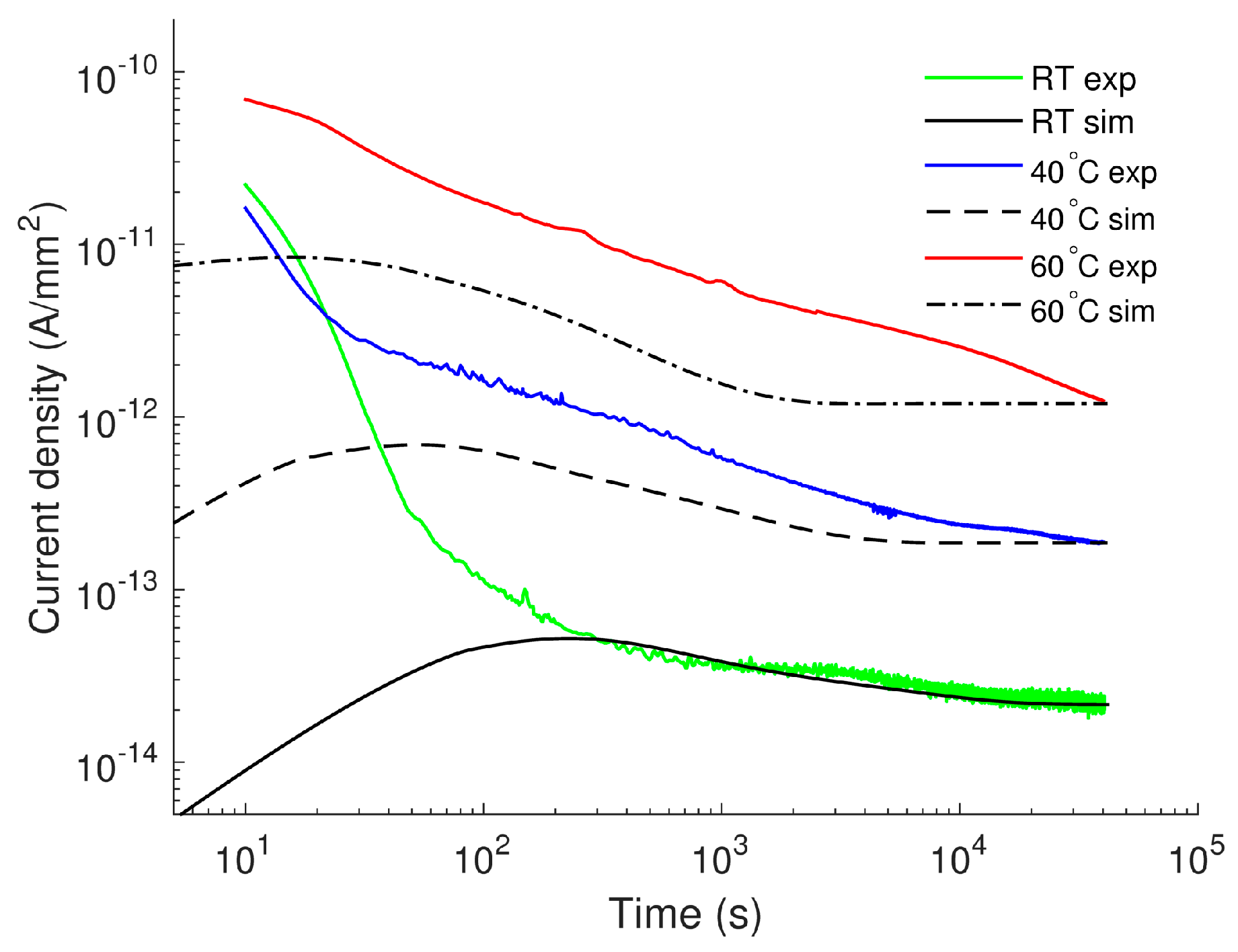

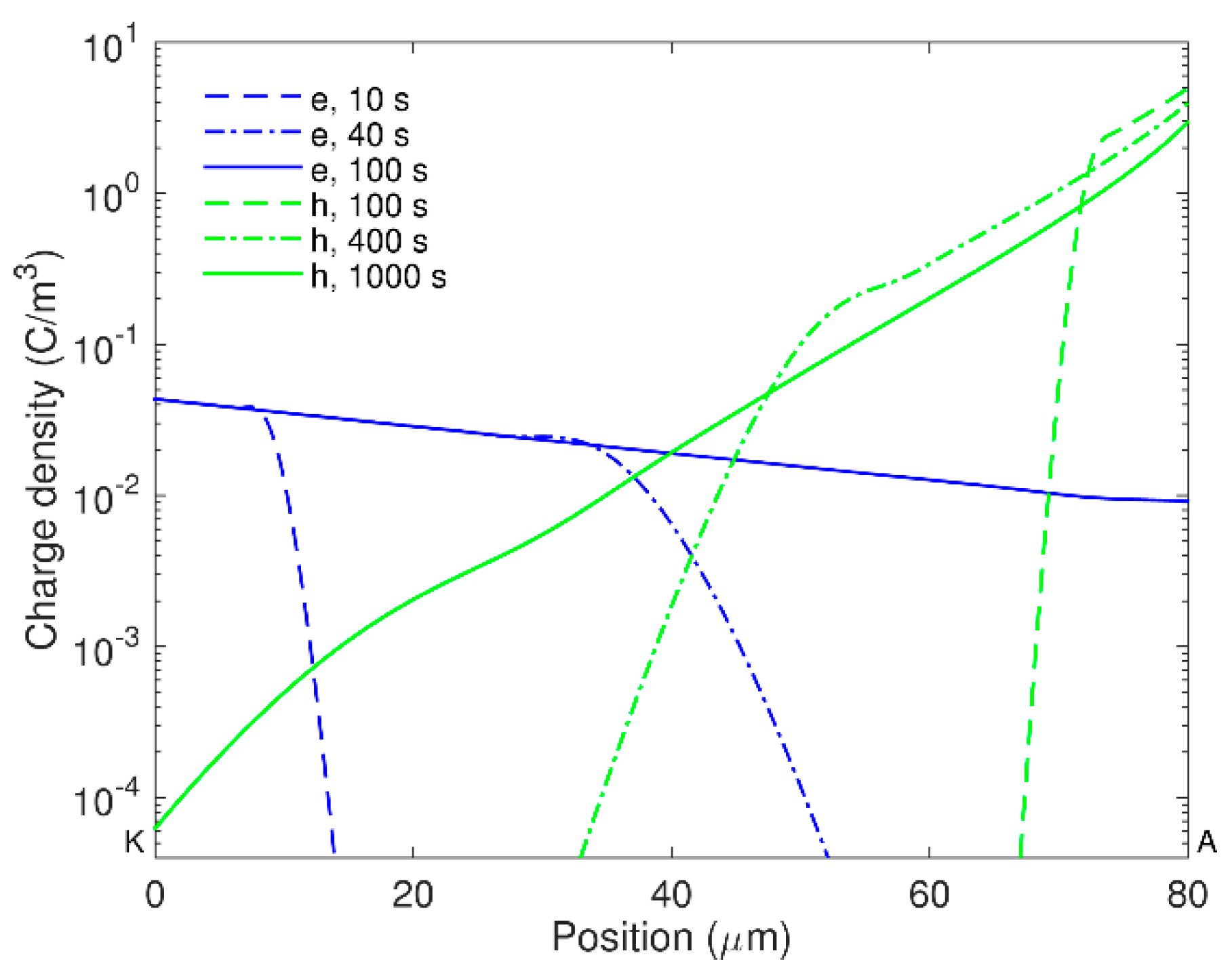
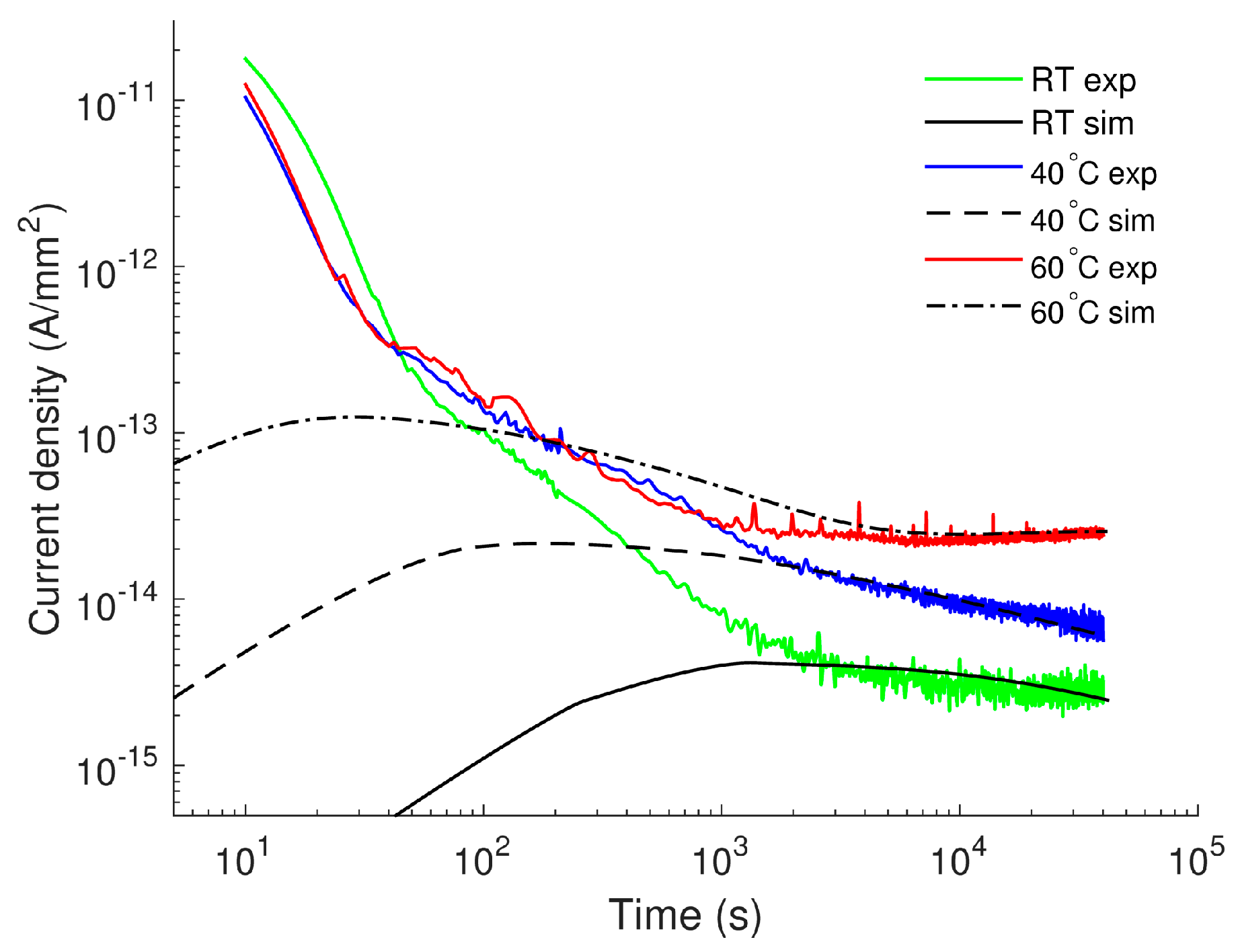

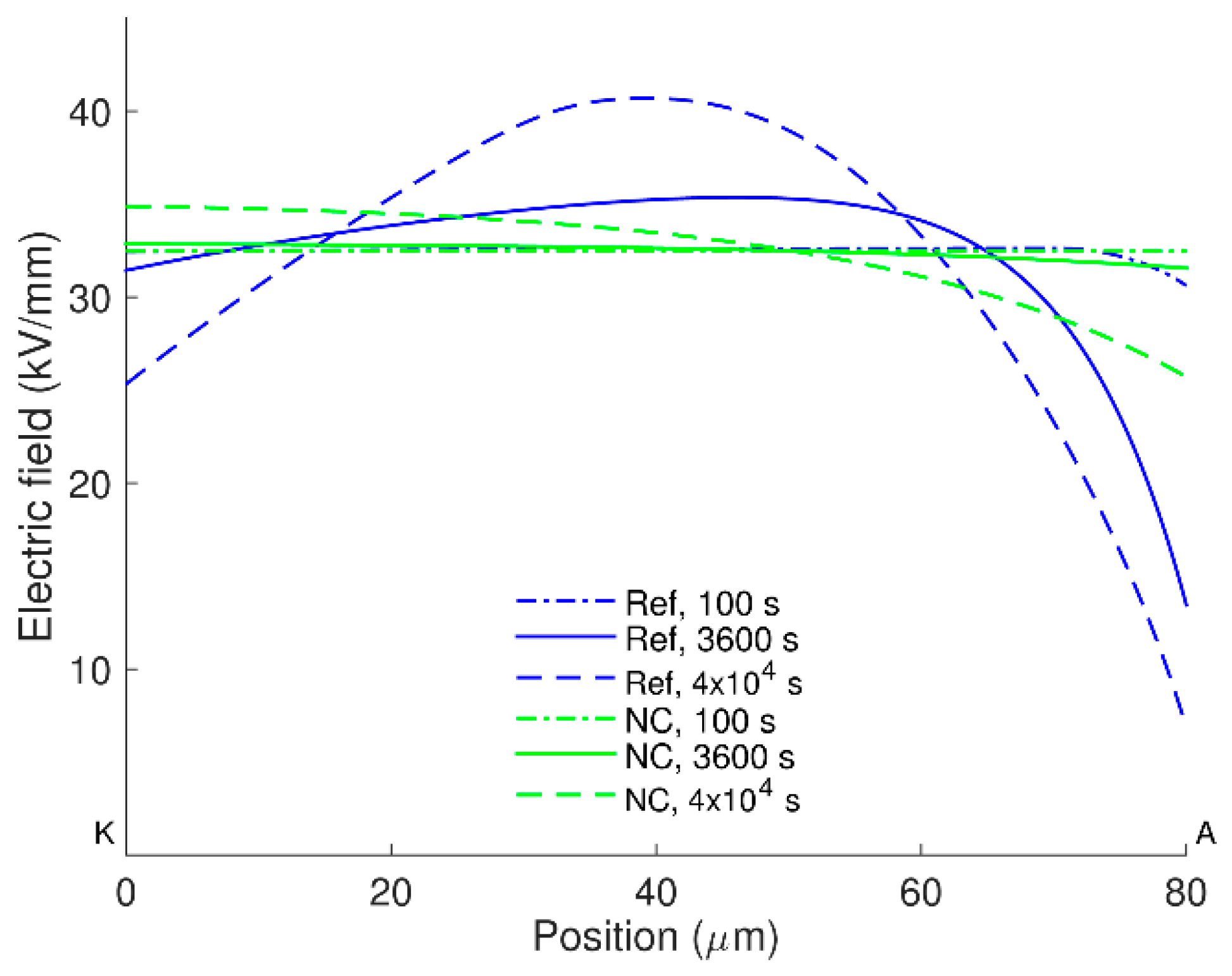
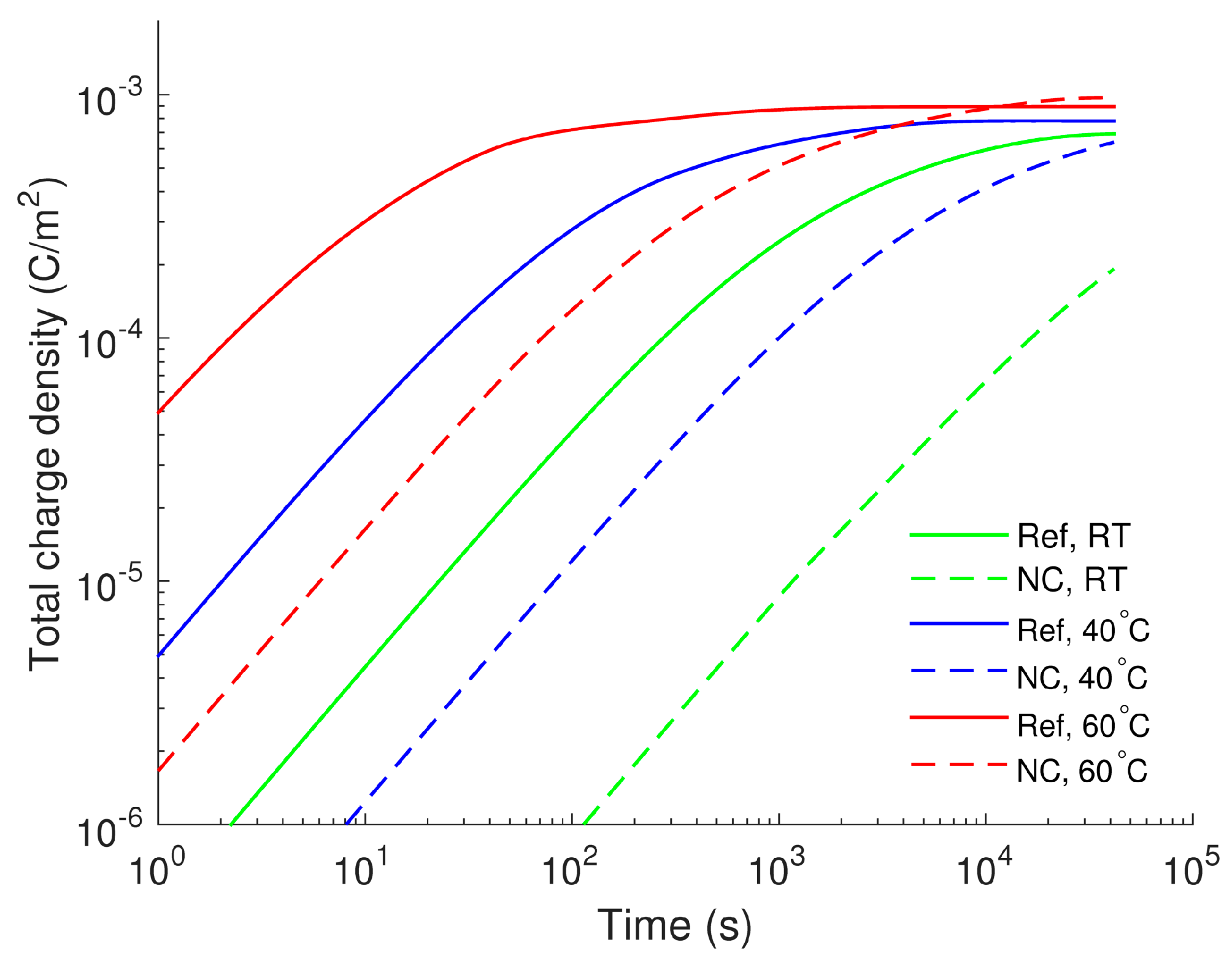
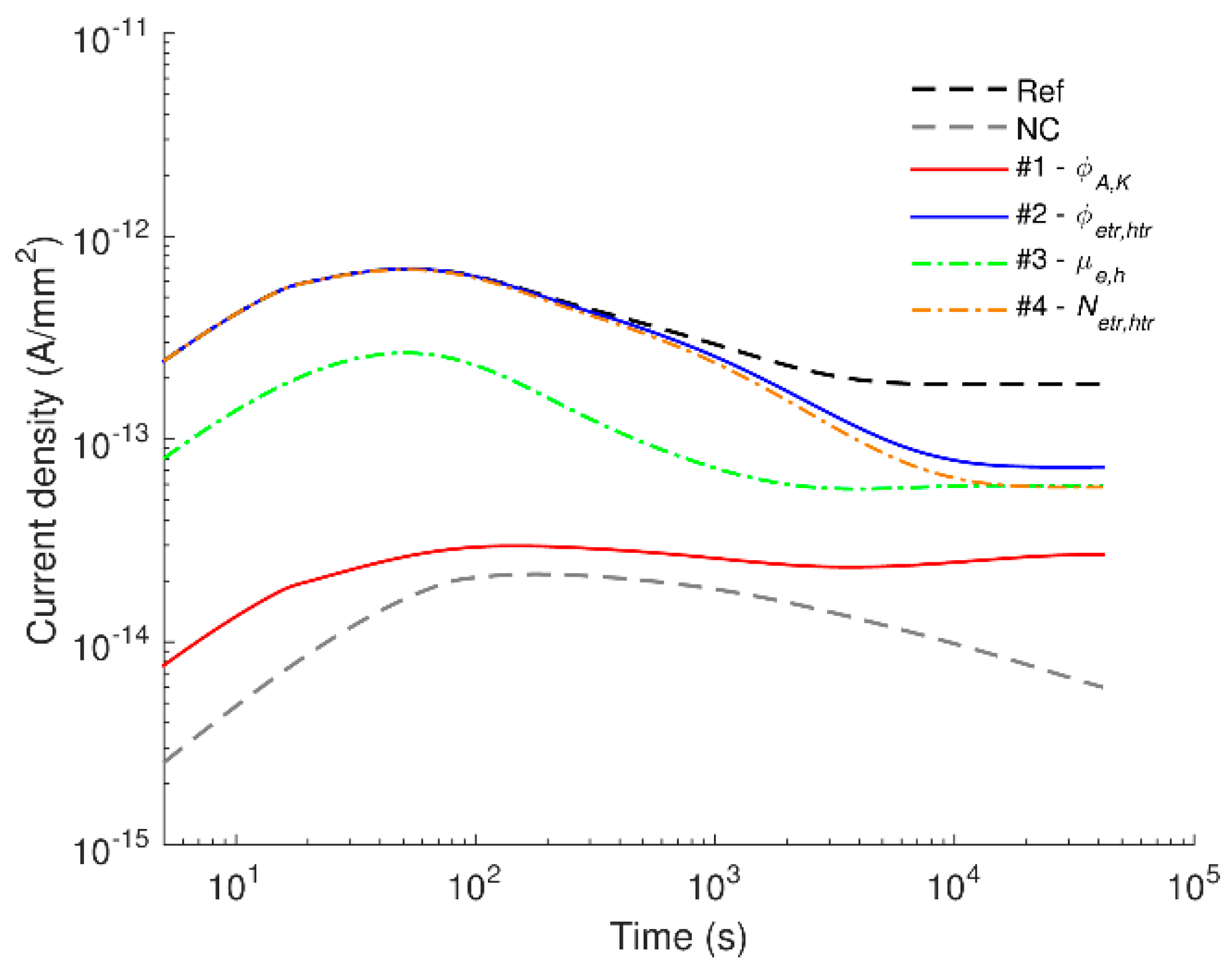

| parameters | LDPE | LDPE Nanocomposites | ||||
|---|---|---|---|---|---|---|
| RT | 40 °C | 60 °C | RT | 40 °C | 60 °C | |
| Effective mobility | ||||||
| µe, m2·V−1·s−1 | 3.0 × 10−14 | 1.5 × 10−13 | 5.5 × 10−13 | 1.0 × 10−14 | 3.0 × 10−14 | 7.0 × 10−14 |
| µh, m2·V−1·s−1 | 2.5 × 10−15 | 1.2 × 10−14 | 5.0 × 10−14 | 2.0 × 10−15 | 6.0 × 10−15 | 1.4 × 10−14 |
| Trapping coefficients | ||||||
| te, s−1 | 0.02 | 0.08 | 0.25 | 0.002 | 0.022 | 0.13 |
| th, s−1 | 0.01 | 0.03 | 0.08 | 0.002 | 0.022 | 0.13 |
| De-trapping barrier height | ||||||
| φetr, eV | 0.93 | 0.96 | 1.00 | 1.00 | ||
| φhtr, eV | 0.93 | 0.96 | 1.00 | 1.00 | ||
| Deep trap density | ||||||
| Netr, m−3 | 1.25 × 1021 | 6.25 × 1021 | ||||
| Nhtr, m−3 | 1.25 × 1021 | 6.25 × 1021 | ||||
| Schottky injection barriers | ||||||
| φK, eV | 1.22 | 1.31 | ||||
| φA, eV | 1.16 | 1.26 | ||||
| Recombination coefficients | ||||||
| retrhtr, m3·s−1 | 6.4 × 10−22 | 6.4 × 10−22 | ||||
| retrh, m3·s−1 | 6.4 × 10−22 | 6.4 × 10−22 | ||||
| rehtr, m3·s−1 | 6.4 × 10−22 | 6.4 × 10−22 | ||||
| reh, m3·s−1 | 0 | 0 | ||||
| Relative permittivity | ||||||
| εr | 2.3 | 2.3 | ||||
| Scenario | Description | Model parameters | Modified parameters |
|---|---|---|---|
| #1 | Reduction of charge injection at electrodes | Charge injection barrier heights as for the nanocomposite, all other parameters as for LDPE | φK = 1.31 eV φA = 1.26 eV |
| #2 | Reduction of charges released from deep traps | De-trapping barrier heights as for the nanocomposite, all other parameters as for LDPE | φetr = 1.00 eV φhtr = 1.00 eV |
| #3 | Reduction of charge carrier mobility | Mobility of electrons and holes as for the nanocomposite, all other parameters as for LDPE | µe = 1 × 10−14; 3 × 10−14; 7 × 10−14 µh = 2 × 10−15; 6 × 10−15; 1.4 × 10−14 |
| #4 | Increase of trap densities | Trap densities as for the nanocomposite, all other parameters as for LDPE | Netr = 6.25 × 1021 m−3 Nhtr = 6.25 × 1021 m−3 |
© 2016 by the authors. Licensee MDPI, Basel, Switzerland. This article is an open access article distributed under the terms and conditions of the Creative Commons by Attribution (CC-BY) license ( http://creativecommons.org/licenses/by/4.0/).
Share and Cite
Hoang, A.T.; Serdyuk, Y.V.; Gubanski, S.M. Charge Transport in LDPE Nanocomposites Part II—Computational Approach. Polymers 2016, 8, 103. https://doi.org/10.3390/polym8040103
Hoang AT, Serdyuk YV, Gubanski SM. Charge Transport in LDPE Nanocomposites Part II—Computational Approach. Polymers. 2016; 8(4):103. https://doi.org/10.3390/polym8040103
Chicago/Turabian StyleHoang, Anh T., Yuriy V. Serdyuk, and Stanislaw M. Gubanski. 2016. "Charge Transport in LDPE Nanocomposites Part II—Computational Approach" Polymers 8, no. 4: 103. https://doi.org/10.3390/polym8040103
APA StyleHoang, A. T., Serdyuk, Y. V., & Gubanski, S. M. (2016). Charge Transport in LDPE Nanocomposites Part II—Computational Approach. Polymers, 8(4), 103. https://doi.org/10.3390/polym8040103





